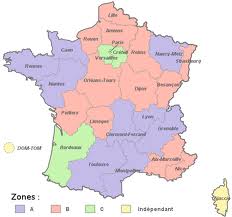Why are there three zones (A, B and C) for the school holidays in France? you may ask yourself. The zones were created in 1965, and dictate when a school in a particular location will have its holiday. For the last 30 years, the school holidays have punctuated the life of France, the universe and everything, and French living really does revolve around the holidays.
For someone from New Zealand, I find that there are a few too many holidays, but at the same time, with the longer school days (9am-5pm, four days a week) I find the children are really ready for a break. There are many, many school holiday activities available for the children (you have to pay of course), and you can also book a holiday home for a week (a gîte) and spend a week exploring a new part of France. This is our favourite holiday occupation. (The end of the holidays is quite good too, when the children all return to school…)
The zones are not necessarily in adjoining areas of France, but are designed to split the population evenly for the following key reasons.
- Let’s go skiing: The primary reasons are for the economy and tourism. These are the holidays during which (nearly all) French people go skiing. Ski stations have paid an enormous sum for their equipment (e.g. ski lifts), and because the snow cover period is not long the holidays are staggered throughout the country so that the ski stations are full/open for several weeks.
- To avoid traffic jams: The idea of staggering the holidays was applied to the spring holidays too. Thus, all families do not leave with their loaded down Renaults at the same time and it therefore decreases the risk of gridlock/truly horrific traffic jams. It also spreads the availability of holiday locations to rent.
- To help with the grape harvest: Originally, the school holidays were the same for everyone throughout France, and were organised around religious holidays (e.g. Christmas, Easter, etc). Additionally, the holiday also allowed school children time to help their parents in the fields. In the 15th century, the holidays were held to coincide with the grape harvest, so everyone could pitch in and get the job done. This is a mostly automated system now but it’s still a good reason for a holiday.
Back to school (La rentrée) Whatever their age or type of school, students start their new school year at the beginning of September. Teachers return on the 1st of September, pupils usually on the 2nd but this always depends on how the weekend falls.
All Saints holidays (Toussaints) All Saints holidays start on the last weekend before the 1st of November and last two weeks. The weather is lovely autumn weather, with quite warm temperatures.
Christmas holidays (Noël) Christmas holidays last two weeks and they encompass Christmas and New Year (Noël et Réveillon), and they are always two full weeks’ long. It’s cold now.
Winter holidays (L’hiver) Winter holidays last two weeks, and are distributed in France depending on which zone you live in. They take place between the second week of February and the first week of March. It can be even colder now, with more chance of snow.
Easter holidays (Pâques) Easter holidays last two weeks and occur between the second week of April and the first week of May. Gorgeous temperatures at this spring time of year make this my favourite holiday period.
Summer holidays (L’été) The summer holidays officially begin in early July for all state schools, and all students and they last two months – July and August – with August being the ‘dead month’ in France where everything is closed, everyone is at the beach or walking in the cool air of the mountains, and tourists should stay away! It is hot, hot, hot. We’ve had up to 38 degrees Celsius, but that’s nothing compared to the temperatures my sister gets in Wagga Wagga, inland Australia!
In summary, I do find that the holidays are interspersed nicely throughout the year, and make each term not too long or arduous. I really like the northern hemisphere thing of starting school at the end(ish) of summer, which is course is the beginning of September, and I loved that Christmas and New Year holidays do not coincide with the end of the school year and the long annual holidays as it does in New Zealand. It all happens at once there, and I really (really) prefer the rhythm of life here.
By the way, the zones are:
Zone A includes Caen, Rennes, and Nantes in the North West, Toulouse, Clermont-Ferrand, Lyon, Grenoble and Montpellier in the South, and Nancy-Metz in the North East;
Zone B includes Lille, Rouen, Amiens, Reims, Strasbourg, Besançon, Dijon, Orleans-Tours, Poitiers, Limoges in central France (but excluding Paris) and Aix-Marseille and Nice in the South East;
Zone C Paris and Versailles, Créteil along with Bordeaux in the South West.
Lots of this information was taken from and article
written by R Botte in Mon Quotidien, vendredi 1 mars 2013 that draws on
a book on holidays and free time written by a French sociologist,
M.Jean Viard. Also some of it is from Wikipedia.

France has always been one of the best place to spend a quality vacation period. I am looking forward to visit the ethnic beauty once again.
ReplyDelete